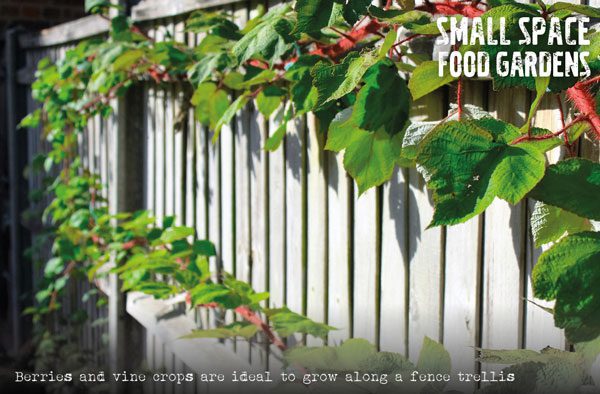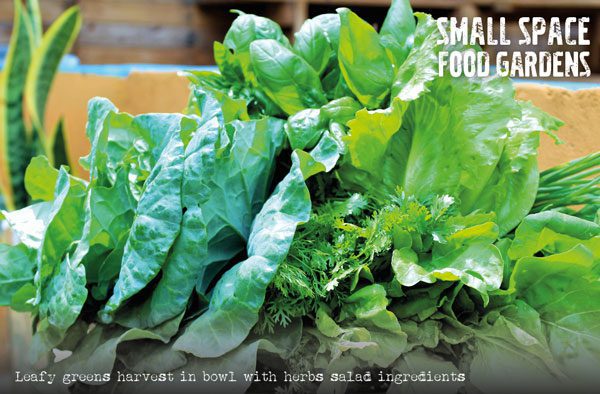With more people concerned about their health and food security, many are now prioritizing growing a food garden in urban spaces. There’s increased interest in small space gardening for many reasons: to be more self-reliant and sustainable, have greater control over the source and quality of food, and reliable access to fresh ingredients.

One of the biggest challenges many gardeners face is understanding how to work with the space around their homes. No one’s space is perfect. Some of the most common problems are being overshadowed by neighboring buildings, poor soil, or no soil for apartments and high-rises, and making poor plant choices. Many people also have limited budgets to get started, so every cent and decision counts.
Expand Your Available Growing Space
Don’t accept the limitations of the space you have; assess the opportunities as if you were a visitor to your home. Try to see your garden through a new ‘lens.’ Consider swapping ornamental plants for edibles. It may be tough to part with them, but they certainly can’t feed you! Along with nutritious food, many edibles have beautiful flowers, colors, and textures. A few suggestions include:
- Dwarf fruit trees with a compact growth habit like kumquats and calamondins or prune citrus to shape.
- Blueberry bushes, Rosellas, Goji berries or Feijoas.
- Camellia sinensis – use the leaves and leaf buds of this attractive flowering shrub to grow your own tea. It also makes a beautiful hedge or privacy screen.
- Flowering herbs like pineapple sage and perennial basil. They look as good as they taste and smell.
Grow up.
Sunlight may not always reach the ground, mainly where buildings are close together, so the ideal place for planting may be vertical. Growing up on a fence or wall where there’s more sunlight can open up new opportunities to grow more edibles in a small space. There are a wide variety of vertical garden options from wall planters, hanging baskets and trellises, to arbors, pergolas, posts, balcony railings, and window boxes. Vines and climbing crops are ideal for maximizing your space.

Think outside the box.
Sometimes there are opportunities literally on or over the fence. By looking beyond the space inside your boundary fence, there can be endless possibilities if you think creatively. One of the first things I do when visiting my clients’ gardens is to assess the ‘borrowed landscape’ on all sides of neighboring fences. I discuss how well they know their neighbors, whether they’d be prepared to create a living green wall vertically or utilize the overhanging shared tree canopy.

Community garden plots and verges.
If you have minimal space, it may be worth expanding your growing area by renting a raised garden bed at a local community garden. If you don’t have one, perhaps a neighbor has an unused garden bed or space they are willing to let you use in return for a share of the harvests. Front verges may also be a possibility if your council is agreeable. Think collaboratively and win-win!
Tips for Small Food Gardeners
Healthy soil yields the best results.
Whether you’re growing in pots or a garden bed, soil quality plays the primary role in the health and volume of your harvest. In terms of priorities, make sure your soil or growing medium:
- is alive with microorganism;
- has good structure, drainage, and aeration;
- contains organic matter like compost to feed your plants;
- has moisture-holding capacity.
Plants with consistent access to adequate sun, nutrients, and moisture can produce to their optimum capacity.

Compare costs.
Seedlings save you valuable growing time, but seeds are cheaper to sow. A bunch of herbs may cost you $3 at the supermarket, but a pot with a mature herb may only be $5, and you can start picking immediately with no more food waste. Grow food you love to eat or costs the most in your weekly shop. ‘Cut-and-come-again’ lettuces and Asian greens are fantastic value because you can pick continuously over the growing period, not just harvest once. One head of lettuce may cost around $3; you’ll save money sowing seedlings instead and save free seeds so you’ll never have to repurchase lettuce.
Harvest swaps.
One way to access food you don’t grow at home is to share what you have with others in return for what you need at a Crop Swap. This simple bartering system is a way to leverage everyone’s time, skills, and space. Whether you attend a formal group in your neighborhood that gather regularly to swap and share surplus produce, preserves, plants, seeds, and cuttings, or connect with your gardening friends and neighbors, it’s incredible how you can expand what you can access. It’s also an excellent opportunity to learn how to grow or use foods you may not be growing yourself.
Select Your Plants Thoughtfully

Roots and greens.
There are many vegetables that you can harvest multiple parts for food. For example, you can pick the young tender leaves of beetroot and sweet potatoes as leafy greens, as well as enjoying the mature root crop when ready to harvest. Coriander leaves, roots, and seeds are all edible and picked at different stages of growth.

Be content with smaller harvests.
Sometimes you need to lower your expectations of picking a big volume of vegetables and be prepared to compromise. Compact cultivars may not yield as many vegetables as larger varieties, but at least you can grow them in a small space. You may only be able to have one pot of tomatoes, so pick a high-yielding variety with a long harvest period. Dwarf or miniature plant varieties are still nutritious but offer the advantage of saving you space.
Choose fast rather than slow-maturing varieties.
It makes sense for many small space gardeners to grow a wider range of edibles, so there’s a continuous supply of ingredients each week, rather than waiting long periods between harvests. Some vegetables like cauliflower and broccoli take months before you can put them on the table. Whereas radishes, bush peas, and beans, leafy greens like lettuce, spinach, rocket, and baby beetroot are ready for harvest in much shorter timeframes.
Heavy croppers in pots.
Tomatoes, capsicums, potatoes, and eggplants are all in the same plant family and provide a great yield-to-space ratio. Capsicums and eggplants are grown as perennials in warm climates so provide long term value.
Grow space hogs and slow crops as microgreens.
Some vegetables that take up too much space and time to mature in the garden like broccoli and red cabbage can be grown as microgreens and harvested for their baby leaves. You don’t miss out on the nutrients, but you certainly save on the space and time waiting for fresh ingredients!
Microgreens and Sprouts.
Sowing seeds in tiny containers or trays and harvesting as baby leafy greens saves a huge amount of space while allowing you to grow a diverse range of vegetables and herbs. Sprouting seeds can be done in a jar on the kitchen bench indoors for quick fresh ingredients year-round. No need for a garden at all.

Leafy greens for salads and stirfries.
There are so many varieties of lettuce, spinach, kale, chard, silverbeet, rocket, and Asian greens that provide quick picks for short and long harvest periods. Spinach and kale freeze well, extending the harvest. These crops also gift you an abundance of free seeds so you can start the cycle again without spending money.
Plants with big yields and space requirements.
If you want to grow your favorite foods like zucchinis or cucumbers that need more room, you may feel you can justify allocating the extra space because they are long croppers and produce a lot of vegetables in return. You may have to sacrifice other crops to grow the ones you spend the most money on or those you can’t squeeze in. One healthy tomato plant can yield several kilos of fruit and is a good choice if you enjoy salads or cook with tomatoes regularly.
Perennials vs annuals.
Long-lived edibles like perennial leeks, perpetual spinach, and asparagus will last years. Annual crops like beans and peas produce a crop over several months and then die off, so you have to replant. Understanding the lifecycle of each crop is essential so you can decide which plants to prioritize growing in the space you have. Quick ‘in and out’ vegetables can fill in spaces around those you plant in a permanent position.
Growing a food garden in a small space can be just as pretty and productive as larger gardens when you apply good design principles and make careful choices. With a little creative thinking, your edible garden can provide an abundance of food throughout the seasons – both indoors and out.



